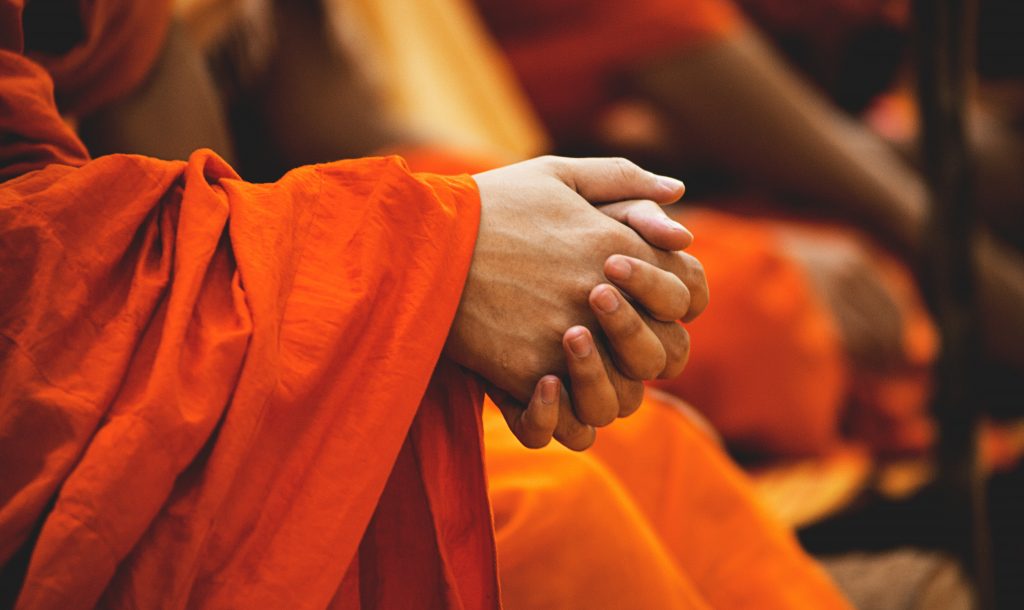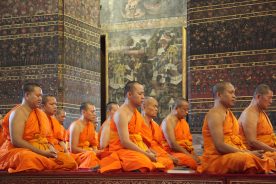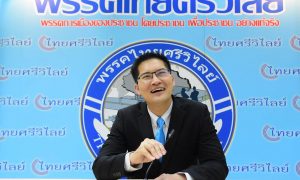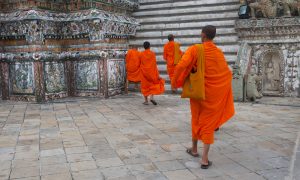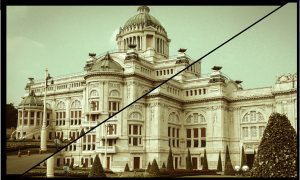In Buddhist ethics, people acquire merit by good works and demerit from wrongdoing, and the resulting account balance determines future lives. Fifty-five years ago, Lucien Hanks argued that this concept underlay Thailand’s hierarchical sociopolitical order. Today this idea can be used to explain why authoritarianism and hierarchy seem to have triumphed over democracy and egalitarianism in Thailand. Thaksin failed because he did not have enough accumulated merit. The “good people” rule.
This thinking obviously has more appeal to those at the upper levels of the social order than to those nearer the bottom. Religious concepts are only one input into popular mentality. Ideas rise and fall. In an era which emphasizes enrichment, getting ahead, education, progress, self-improvement, such ideas lose traction. Anyone scanning Thai society today can see that some of the richest and most powerful figures have acquired their riches and power within their own lifetime, and that they regularly break all or most of the precepts. Of course, that can be rationalized within the merit-and-karma framework (their current success depends on past merit), but people are likely to take a simpler view that merit has nothing to do with it.
Conservative ideologues promote the ‘law of karma’ to persuade people to accept the status quo and their place within it. But modern interpretations of merit and karma allow more room for the individual and for action within this life.
The form of Buddhism practiced in Thailand, now dubbed Theravada, also enshrines an egalitarian theme. All can participate. Any man can become a monk. The maintenance of the monkhood depends on the patronage of the laity, and all are encouraged to participate, starting from the daily ritual of feeding the monks. In matters spiritual, the monkhood has precedence, so even kings bow before them with respect. This egalitarian aspect seems to have been important in the popular adoption of this “Lankan” practice in Southeast Asia in the 12th to 14th centuries. The Christian missionaries who arrived later, expecting easy conversion, gave up when they understood the level of popular involvement with the monkhood and religious practice.
Thailand’s sangha: turning right, coming full circle
Thailand’s military government has passed an amendment to the Sangha Act that places the power to appoint and remove the twenty members of the Sangha Council, the highest governing body in the Thai Buddhist order, under the king’s power.
Rulers everywhere call on religion to lend their authority the special backing of divinity. As Buddhism has no gods, it fails to fulfil this role. From the early Ayutthaya era, Siamese kings imported Indian Brahmans to instil in the king some of the divinity of the power gods of Hinduism. This procedure remains the core of the Thai coronation ceremony to this day.
But Buddhism and power became related in another way. Across Asia there were old beliefs in spirit forces that controlled the operations of nature and the course of history. Adepts who practiced self-control through austerities claimed to understand and control these forces. This tradition was merged into Siamese Buddhism by linking these ascetic techniques with the austerities undergone by the Buddha to achieve enlightenment and nibbana. The Buddha was credited with superhuman powers, including the ability to remember his own past lives, and to perform several miracles recounted in his scriptural biography. Others could achieve similar superhuman abilities through the same techniques.
In several Buddhist cultures, these ideas were suppressed or were isolated as an extreme and perhaps heretical strain, with labels such as “esoteric” and “tantric.” But in Siamese Buddhism, this element became part of the mainstream. The miraculous aspect is prominent in the presentation of the Buddha’s life. Monks of the “forest” (rather than “city”) type practiced various austerities and were consulted for help in predicting the future or influencing the spirit forces that lay behind everyday life. By the 17th century, European visitors noted that such monks were the most popular. Several words for “power” adapted into Thai from Pali-Sanskrit may also mean “supernatural power.” The same goes for “knowledge.”
Here was a Buddhist basis for royal authority. Kings were identified as bodhisattas, Buddhas-to-be, accumulating merit through successive lives, and credited with superhuman abilities. When this formulation emerged is unclear but it was present in the Narai reign in the later 17th century, and flourished in the 18th. It emerged alongside a powerful royal absolutism, and provided justification for the elevation of the king to a superhuman level, similar to the idea of divine right in Christian tradition. (The concept of the devaraja or god-king is often attributed to this role, but the concept is hard to find in the sources.)
The difficulty was that kings could not impose a monopoly on this kind of power. Anyone could practise austerities and learn mantras. Late Ayutthaya is littered with revolts led by monks or ex-monks who had acquired a reputation for ascetic ability, and who often promised the bouleversement associated with the coming of the future Buddha, Si Ariya or Metteyya. An anti-authoritarian strain, based on the same complex of ideas, runs through the popular literature of the time, especially Khun Chang Khun Phaen and Si Thanonchai.
This was clearly too dangerous, and prompted a historical shift. From the late 18th century, the kings quietly backed away from bodhisatta-kingship (reverting to the Hindu gods), and tried many ways to control, eliminate, or neutralize this strain of wild power in Thai Buddhism. King Rama I instituted legislation to forbid monks from dabbling in these ideas, and promoted religious education to wean both monks and laity onto a more orthodox path. These measure were of limited effect. Heretical monks and millennial promise continued to figure in revolt and resistance, especially against the territorial expansion of the state into Lanna and Isan in the late 19th century. A further round of legislation and reforms to “cleanse” the Sangha at the turn of the 20th century was no more effective. Millennialism again inspired revolt in the 1920s.
More effective than legislation and education, however, was simply the state’s enormously increased powers of violence. Revolts were relatively easily suppressed by a new standing army equipped with modern weaponry. At the same time, the royalist state gave up trying to suppress the radical-ascetic trend within Thai Buddhism, and instead offered it patronage. Some of the most prominent monks of the late 19th century, now famous for their amulets, were welcomed into the Thammayut sect founded by King Mongkut. So too were the lineages associated with Acharn Man Phurithatto and other ascetic monks popular in the northeast during the era of communist insurgency.
By the late 20th century, the monkhood had been bureaucratized, and the wild strain within Thai Buddhism had been neutralized. Even so, the state and conservative forces remained wary about any association between Buddhism and formal politics. Monks gave support to protests over land rights, infrastructure projects, and environmental issues without attracting any opposition or censure. But the state cracked down on any movement that crossed into formal politics.
Around 1970, a spirit medium and faith healer who explicitly drew on the wild strain launched a movement named Hupphasawan to save Thailand and the world through moral generation. He gained patronage to build a pan-faith theme park, and was seemingly accepted by the Supreme Patriarch, but when he made contact with foreign political leaders, and called on the king to dispense with the government, the movement was suppressed and its leader jailed. In 1975, a former entertainer and monk launched the Santi Asoke movement based on a strict and ascetical practice of Buddhism. Although questioned by the Sangha authorities, the movement flourished until the late 1980s. But when its members became involved in the Palang Dharma Party and electoral politics, Santi Asoke was expelled from the Sangha and its political activities suppressed. From the early 1990s, the Dhammakaya movement excited controversy because of its heretical teachings (miracles) and financial irregularities (large landholdings in the personal name of the abbot), yet continued to grow and flourish until the early 2000s. When it then became connected, through the real estate industry, into the political coterie of Thaksin Shinawatra, the movement was peppered with lawsuits and its centre was repeatedly raided by security authorities until its leader disappeared into hiding.
Over a century ago, Thai Buddhism was cemented into the establishment triad of “Nation, Religion and King.” But there remains a certain “unruliness” embedded in its dispersed organization and ideas on power.
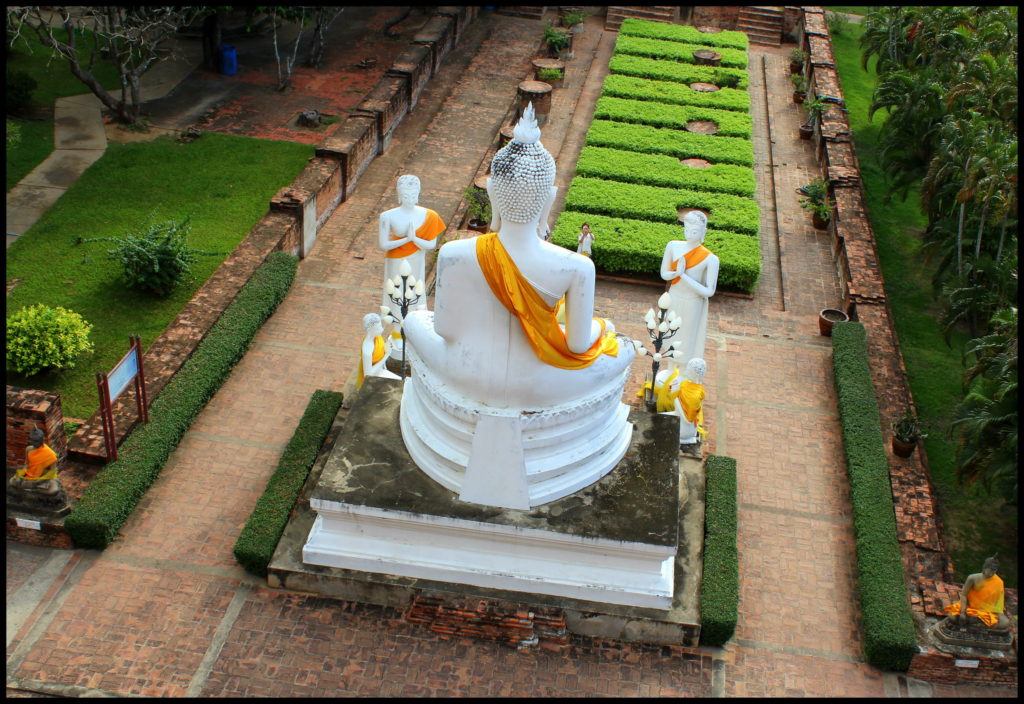 Photo: Tohr l’Alchimista on Flickr, Creative Commons
Photo: Tohr l’Alchimista on Flickr, Creative Commons
ตามหลักธรรมของพระพุทธศาสนา ผู้คนได้บุญด้วยการทำความดี ได้บาปด้วยการทำความชั่ว และผลลัพธ์จากยอดดุลนั้นจะส่งผลต่อชาติหน้า ทั้งนี้เมื่อ 55 ปีก่อน ลูเซียน แฮงส์ (Lucien Hanks) เสนอว่า แนวคิดนี้เป็นหลักการพื้นฐานของลำดับชั้นในทางสังคมและการเมืองของประเทศไทย และในปัจจุบัน นักวิชาการใช้แนวคิดนี้อธิบายว่าเพราะเหตุใดในประเทศไทย แนวคิดอำนาจนิยมและลำดับช่วงชั้นสูงต่ำจึงมีชัยเหนือประชาธิปไตยและแนวคิดเสมอภาคนิยม ส่วน ‘ทักษิณ ชินวัตร’ ล้มเหลวเพราะเขาสั่งสมคุณงามความดีไม่พอ ผู้ปกครองต้องเป็น “คนดี”
ความคิดเช่นนี้ดึงดูดใจผู้ที่อยู่ในลำดับทางสังคมชั้นสูงมากกว่าผู้ที่เป็นคนชั้นล่างอย่างเห็นได้ชัด แนวคิดทางศาสนาเป็นเพียงหนึ่งแหล่งป้อนข้อมูลสู่ความคิดของมวลชน แต่แนวคิดเติบโตได้ก็ตกต่ำได้ ในยุคที่คนให้ความสำคัญต่อความร่ำรวย การศึกษา ความก้าวหน้า การพัฒนาตนเอง แนวคิดเช่นนี้สูญเสียแรงดึงดูดใจ ใครก็ตามที่กำลังวิพากษ์สังคมไทยทุกวันนี้ จะมองเห็นได้ว่าคนที่รวยและมีอำนาจมากที่สุดบางคนนั้นมั่งคั่งและพุ่งสู่อำนาจภายในชั่วชีวิตของพวกเขานั้นเอง และทำได้โดยผิดศีลหลายข้อ แน่นอนว่าปรากฎการณ์นี้สามารถอธิบายได้ภายในกรอบ “บุญ-กรรม” (ความสำเร็จในปัจจุบันของพวกเขาขึ้นอยู่กับผลบุญในอดีต) แต่คนทั่วไปกลับถือเอามุมมองที่ง่ายกว่านั้นไปอีกว่าผลบุญไม่เกี่ยวอะไรกับเรื่องนี้
นักอนุรักษ์นิยมส่งเสริมแนวคิด “กฎแห่งกรรม” เพื่อโน้มน้าวผู้คนให้ยอมรับในสถานะปัจจุบันและตำแหน่งแห่งที่ของพวกเขาภายในสังคม แต่การตีความยุคใหม่ในเรื่องบุญและกรรมนั้น ได้ให้พื้นที่แก่ปัจเจกบุคคลและการกระทำภายในชาตินี้
รูปแบบของพระพุทธศาสนาที่ปฏิบัติกันในเมืองไทย ซึ่งต่อไปนี้จะเรียกว่า ‘เถรวาท’ ก็ยกย่องบูชาในประเด็นความเสมอภาค ทุกคนสามารถมีส่วนร่วม ผู้ชายทุกคนสามารถบวชเป็นพระ การบำรุงรักษาสถาบันสงฆ์พึ่งพิงการอุปถัมภ์ของฆราวาส และทุกคนมีส่วนร่วมได้ เริ่มต้นจากใส่บาตรทุกวัน ในเรื่องทางธรรม พระสงฆ์ก็มีลำดับฐานันดร ที่แม้แต่พระมหากษัตริย์ก็ต้องก้มพระเศียรให้แก่พระสงฆ์ก่อนด้วยความเคารพ ความเสมอภาคนี้ดูเหมือนจะมีความสำคัญในการรับเอาวัตรปฏิบัติอย่าง “ลังกา” มาใช้ในเอเชียตะวันออกเฉียงใต้อย่างแพร่หลายเมื่อศตวรรษที่ 12 ถึง 14 หลังจากนั้น เมื่อมิชชันนารีชาวคริสต์มาถึงภูมิภาค เดิมคาดหวังว่าจะชักจูงผู้คนให้เปลี่ยนศาสนาได้ง่ายๆ ก็เป็นอันล้มเลิกเสีย เมื่อพวกเขาตระหนักรู้ถึงระดับการมีส่วนร่วมของมหาชนทั้งที่บวชเป็นพระและที่ปฏิบัติศาสนกิจ
นับตั้งแต่ต้นยุคสมัยใหม่เรื่อยมา นัยสำคัญของพระพุทธศาสนาในชีวิตประจำวันทำให้ผู้นำทางการเมืองของสยามปรารถนาจะควบคุมและใช้อิทธิพลของศาสนาให้เป็นประโยชน์ แต่นี่เป็นเรื่องยาก สภาบันสงฆ์ประกอบด้วยผู้สืบสายผ่านการอุปสมบทหลายสาย (พระสงฆ์ที่ผ่านการอุปสมบทจึงมีสิทธิที่จะอุปสมบทผู้อื่น) ซึ่งรวมตัวกันอย่างหลวมๆ เป็นนิกาย พระสงฆ์ในแต่ละวัดจะเลือกเจ้าอาวาสของพวกเขา โดยร่วมมือกับชุมชนท้องถิ่น องค์กรจึงมีรูปแบบแนวราบและกระจัดกระจาย พระมหากษัตริย์อาจให้ “ความคุ้มครอง” แต่ปัจจัยนี้ก็มีแรงดึงดูดอย่างจำกัด เมื่อศาสนาไม่ได้เผชิญกับภัยคุกคามอย่างหนัก ขณะที่พระมหากษัตริย์อาจเป็นองค์อุปถัมภ์ผ่านการสร้างวัดและสนับสนุนชุมชนคณะสงฆ์ แต่ก็เป็นค่าใช้จ่ายที่แพงสำหรับพระราชทรัพย์ และในทางปฏิบัติการอุปถัมภ์เหล่านี้จำกัดอยู่เฉพาะวัดสำคัญเพียงไม่กี่แห่ง ทั้งในสมัยสุโขทัยและอยุธยามีหลักฐานว่าพระมหากษัตริย์พยายามที่จะกำหนดลำดับชั้นของคณะสงฆ์ผ่านการพระราชทานสมณศักดิ์ แต่มาตรการนี้อาจไร้ประสิทธิภาพ ค.ศ. 1901 รัฐบาลของพระบาทสมเด็จพระเจ้าอยู่หัวในเวลานั้นร่างแผนผังแสดงโครงสร้างการปกครองคณะสงฆ์แบบขั้นพีระมิด และกำหนดระบบการสอบเพื่อจัดลำดับคณะสงฆ์ แต่ที่จริงโครงสร้างอำนาจนี้ไม่ได้ลงมาสู่ระดับท้องถิ่น อย่างไรก็ตาม ครั้นถึงทศวรรษที่ 1950 เมื่อพื้นที่ทางภูมิศาสตร์หดแคบลงด้วยการติดต่อสื่อสารที่ดีขึ้น โครงสร้างนี้ก็เริ่มมีประสิทธิภาพ พระสงฆ์ศึกษาพระปริยัติธรรมและสอบเพื่อเลื่อนสถานะของตน ระบบการแต่งตั้งพระสงฆ์ที่มีลำดับขั้นลดหลั่นกันลงมา เริ่มจากสมเด็จพระสังฆราช มายังเจ้าคณะจังหวัด เจ้าคณะอำเภอ และเจ้าคณะตำบล เป็นภาพสะท้อนไปกับระบบราชการพลเรือน แต่ถึงกระนั้นพระพุทธศาสนาแบบไทยยังให้พื้นที่สำหรับพระสงฆ์ระดับปัจเจกบุคคลที่จะดึงดูดผู้ศรัทธาเป็นการเฉพาะตัว บนพื้นฐานของความคิดและความน่าสนใจของพวกเขา
ผู้ปกครองในทุกๆ ที่ เรียกร้องให้ศาสนาหยิบยืมอำนาจศักดิ์สิทธิ์มาช่วยสนับสนุนพวกเขา แต่ในเมื่อพระพุทธศาสนาไม่มีพระเจ้า จึงล้มเหลวที่จะเติมเต็มในบทบาทนี้ นับตั้งแต่สมัยอยุธยาตอนต้น พระมหากษัตริย์ของสยามมักอาศัยพราหมณ์อินเดียให้อาราธนาอำนาจของพระผู้เป็นเจ้าในศาสนาฮินดู เพื่อเข้ามาเสริมความศักดิ์สิทธิ์ของพระมหากษัตริย์ แบบแผนเช่นนี้ยังคงเป็นแก่นหลักของพระราชพิธีบรมราชาภิเษกในปัจจุบัน
แต่พระพุทธศาสนาและอำนาจยังคงเกี่ยวข้องกันในทางอื่น ทั่วทวีปเอเชียนั้นมีความเชื่อดั้งเดิมเรื่องอำนาจของผีสางเทวดาที่กำกับความเป็นไปของธรรมชาติและความเป็นมาทางประวัติศาสตร์ นักพรตผู้ฝึกควบคุมตนเองอย่างเคร่งครัดอ้างว่าเข้าใจและสามารถควบคุมพลังเหล่านี้ได้ พวกเขาควบรวมธรรมเนียมเหล่านี้เข้าไปในพระพุทธศาสนาแบบสยามด้วยการเชื่อมโยงพฤติกรรมแบบฤาษีเข้ากับการบำเพ็ญทุกรกิริยาที่ปฏิบัติโดยพระพุทธเจ้าเพื่อเข้าสู่การตรัสรู้และปรินิพพาน พระพุทธเจ้ายังได้รับความนับถือในด้านพลังเหนือมนุษย์ รวมทั้งความสามารถในการรำลึกอดีตชาติของพระองค์ การแสดงปาฏิหาริย์หลากหลายครั้งดังที่เล่าไว้ในพุทธประวัติในพระไตรปิฎก คนอื่นๆ ก็สามารถบรรลุถึงความสามารถแบบเหนือมนุษย์ผ่านวิถีปฏิบัติเคร่งครัดแบบเดียวกัน
วัฒนธรรมของชาวพุทธหลายแห่ง มีการกำราบแนวคิดเหล่านี้หรือโดดเดี่ยวให้กลายเป็นเรื่องสุดโต่ง หรือบางทีมองว่าเป็นแนวทางเคร่งครัดแบบนอกรีต ด้วยป้ายฉลากอย่าง “วัชรยาน” และ “ตันตระ” แต่ในพระพุทธศาสนาแบบสยาม องค์ประกอบเหล่านี้กลายเป็นส่วนหนึ่งของกระแสหลัก แง่มุมด้านปาฏิหาริย์สร้างความโดดเด่นให้แก่ชีวประวัติของพระพุทธเจ้า พระ “ป่า” (ซึ่งแตกต่างจากพระ “เมือง”) ผู้หล่อหลอมวัตรปฏิบัติอันเคร่งครัดนั้น สามารถให้คำปรึกษาและช่วยทำนายอนาคต หรือสร้างอิทธิพลเหนืออำนาจวิญญาณที่อยู่เบื้องหลังชีวิตประจำวัน ศตวรรษที่ 17 ผู้มาเยือนชาวยุโรปบันทึกไว้ว่าพระสงฆ์เหล่านี้ได้รับความนิยมสูงสุด ในภาษาไทย มีหลายคำซึ่งดัดแปลงมาจากภาษาบาลี-สันสกฤต ให้หมายถึง “อำนาจ” และอาจหมายถึง “อำนาจเหนือธรรมชาติ” (อิทธิ ฤทธิ์ ฤทธานุภาพ ศักดิ์ เตช) นอกจากนั้น มีคำที่หมายถึงความ “ความรู้” และอาจหมายถึง “ความรู้เหนือธรรมชาติ” (คุณ คุณไสย ไสยเวท ไสยศาสตร์ อาถรรพณ์ วิชา)
นี้คือฐานรากของพระราชอำนาจที่ยึดโยงกับพระพุทธศาสนา พระมหากษัตริย์คือพระโพธิสัตว์ หรือผู้ที่จะเป็นพระพุทธเจ้าในอนาคต ผู้ซึ่งได้สั่งสมบุญบารมีผ่านการเสวยพระชาติต่อเนื่องกันมา และได้รับความเชื่อถือว่ามีความสามารถเหนือมนุษย์ หลักคิดเช่นนี้ก่อรูปและปรากฏขึ้นเมื่อใดยังไม่แน่ชัด แต่ปารกฎแล้วตั้งแต่สมัยสมเด็จพระนารายณ์มหาราชในศตวรรษที่ 17 และเฟื่องฟูรุ่งเรืองขึ้นในศตวรรษที่ 18 โดยปรากฎตัวขึ้นเคียงข้างไปกับสมบูรณาญาสิทธิราชย์อันทรงพลัง และยังสร้างความชอบธรรมให้กับการยกพระมหากษัตริย์ให้สูงขึ้นไปอยู่ในระดับเหนือมนุษย์ ในลักษณะใกล้เคียงกับแนวคิดเทวสิทธิ์ (divine right) ตามธรรมเนียมในศาสนาคริสต์ (สำหรับเรื่องเทวราชาในสยามนั้น ก็ยากที่จะหาแนวคิดนี้ในหลักฐานทางประวัติศาสตร์)
ความยากก็คือพระมหากษัตริย์ไม่สามารถผูกขาดอำนาจประเภทนี้ได้ ใครๆ ก็สามารถบำเพ็ญตนอย่างเคร่งครัดและเรียนมนต์คาถา ในสมัยกรุงศรีอยุธยาตอนปลายเต็มไปด้วการก่อกบฏที่มีผู้นำซึ่งเป็นพระสงฆ์และอดีตพระสงฆ์ผู้มีชื่อเสียงจากเรื่องความสามารถด้านการบำเพ็ญเพียร และผู้คนเหล่านั้นมักให้คำมั่นสัญญาถึงการพลิกฟ้าคว่ำแผ่นดิน หรือ ยุคพญาธรรมิกราช (bouleversement) รวมทั้งการมาถึงของพระพุทธเจ้าในอนาคตทั้ง พระศรีอาริย์ หรือพระเมตไตรย และยังมีกระแสแนวคิดต่อต้านผู้ใช้อำนาจบาตรใหญ่ โดยอยู่บนพื้นฐานของแนวคิดที่มีความสลับซับซ้อนแบบเดียวกัน ผ่านวรรณกรรมยอดนิยมในเวลานั้นโดยเฉพาะอย่างยิ่งเรื่องขุนช้างขุนแผน และศรีธนญชัย
กระแสดังกล่าวเป็นอันตรายมากอย่างเห็นได้ชัด และสามารถหันเหเส้นทางประวัติศาสตร์ได้ จากปลายศตวรรษที่ 18 พระมหากษัตริย์ค่อยๆ ถอยห่างออกจากแนวคิด “พระมหากษัตริย์ผู้เป็นพระโพธิสัตว์” (กลับไปสู่ความเป็นสมมติเทพแบบฮินดู) และมีความพยายามหลากหลายวิถีทางเพื่อควบคุม ขจัด หรือปรับแปลงพลังนอกขนบในพระพุทธศาสนาแบบไทย พระบาทสมเด็จพระพุทธยอดฟ้าจุฬาโลกมหาราช รัชกาลที่ 1 ทรงออกกฎหมายโดยห้ามพระสงฆ์ไม่ให้รับเอาแนวคิดเหล่านี้ รวมทั้งส่งเสริมการศึกษาทางศาสนาเพื่อชักนำทั้งพระสงฆ์และฆราวาสให้เข้าสู่หลักปฏิบัติแบบขนบจารีตมากขึ้น แต่มาตรการเหล่านี้มีผลอย่างจำกัด พระสงฆ์นอกขนบจารีตและคำสัญญาพลิกฟ้าคว่ำแผ่นดิน ยังคงปรากฏตัวขึ้นเพื่อก่อกบฏและลุกฮือต่อต้าน โดยเฉพาะอย่างยิ่งต่อต้านการขยายอาณาเขตของรัฐเข้าสู่หัวเมืองล้านนาและอีสานในช่วงปลายศตวรรษที่ 19 การออกกฎหมายและปฏิรูปรอบใหม่เพื่อ “ชำระ” คณะสงฆ์ในช่วงต้นศตวรรษที่ 20 ยังคงไม่มีประสิทธิผล ขบวนการผู้มีบุญได้จุดประกายการลุกฮือขึ้นอีกครั้งในช่วงทศวรรษที่ 1920
มาตรการที่มีประสิทธิภาพมากกว่าการออกกฎหมายและการศึกษา กลับเป็นเพียงการที่รัฐขยายอำนาจผ่านการใช้ความรุนแรง รัฐบาลปราบปรามกบฏต่างๆ ลงอย่างง่ายดายก็ด้วยกองทัพประจำการแบบใหม่ที่ติดอาวุธทันสมัย ในเวลาเดียวกันรัฐบาลสมบูรณาญาสิทธิราชย์ก็เลิกล้มความพยายามที่จะกำราบแนวคิดสุดโต่ง-พฤติกรรมแบบฤาษีในพระพุทธศาสนาแบบไทย และทดแทนโดยให้การอุปถัมภ์เสียเลย พระสงฆ์ที่มีชื่อเสียงบางรูปในช่วงปลายศตวรรษที่ 19 บัดนี้มีชื่อเสียงเรื่องเครื่องรางของขลัง ก็ได้รับการต้อนรับเข้าสู่ธรรมยุตินิกาย ซึ่งพระบาทสมเด็จพระจอมเกล้าเจ้าอยู่หัวได้ทรงสถาปนาขึ้นมา นอกจากนั้น สมัยลุกขึ้นสู้ของพรรคคอมมิวนิสต์ พระสงฆ์สายที่เกี่ยวข้องกับพระอาจารย์มั่น ภูริทัตโต และพระสงฆ์ผู้มีวัตรปฏิบัติเคร่งครัดอื่นๆ ที่มีชื่อเสียงในภาคตะวันออกเฉียงเหนือ ก็ได้เช้าสู่นิกายธรรมยุติด้วย
ครั้นถึงปลายศตวรรษที่ 20 ได้ปรับแปลงคณะสงฆ์ให้เป็นสถาบันข้าราชการแล้ว และจัดการให้แนวทางนอกขนบภายในพระพุทธศาสนาแบบไทยสิ้นฤทธิ์ ถึงแม้กระนั้น รัฐและพลังอนุรักษ์นิยมยังคงระมัดระวังเกี่ยวกับความสัมพันธ์ใดๆระหว่างพระพุทธศาสนากับการเมืองภาคทางการ แมม้ว่ารัฐไม่ได้เป็นห่วงมื่อพระสงฆ์สนับสนุนการประท้วงในเรื่องสิทธิที่ดิน เรื่องโครงสร้างพื้นฐาน และสิ่งแวดล้อม แต่รัฐปราบปรามความเคลื่อนไหวใดๆ ที่ล้ำเส้นปสู่การเมืองภาคทางการ
ราวทศวรรษ 1970 ร่างทรงวิญญาณและผู้รักษาโรคด้วยความเชื่อทางศาสนา (faith healer) ผู้ซึ่ง ได้ตั้งขบวนการที่ชื่อว่า “หุบผาสวรรค์” เพื่อรักษาประเทศไทยและโลกผ่านการเยียวยาทางศีลธรรม ได้รับการสนับสนุนให้สร้างสวนที่รวมทุกความเชื่อทางศาสนาเข้าไว้ด้วยกัน และดูเหมือนจะได้รับความเห็นชอบจากสมเด็จพระสังฆราชในเวลานั้น แต่เมื่อเขาพยายามติดต่อกับผู้นำทางการเมืองต่างประเทศ และเรียกร้องให้พระมหากษัตริย์ปลดคณะรัฐบาล ทางการกำราบขบวนการดังกล่าวและจับผู้นำเข้าคุก ค.ศ. 1975 อดีตบุคคลในวงการบันเทิงและพระสงฆ์กลุ่มหนึ่งก่อตั้งขบวนการสันติอโศก โดยยึดโยงกับวิถีปฏิบัติเคร่งครัดแบบพฤติกรรมฤาษี แม้ว่ามหาเถระสมาคมจะแสดงข้อกังขา แต่ขบวนการดังกล่าวก็รุ่งเรืองอยู่จนกระทั่งปลายทศวรรษที่ 1980 เมื่อสมาชิกของกลุ่มเข้าไปมีส่วนร่วมในพรรคพลังธรรมและการเมืองการเลือกตั้ง สันติอโศกก็ไม่อาจอยู่ในมหาเถรสมาคมได้ และทางการกำราบกิจกรรมทางการเมืองของพวกเขา ช่วงต้นทศวรรษ 1990 ขบวนการของวัดพระธรรมกายกลับกระตุ้นให้เกิดความอื้อฉาว เนื่องมาจากคำสอนที่ผิดไปจากจารีต (ในเรื่องปาฏิหาริย์) และความไม่ชอบมาพากลด้านการเงิน (ครอบครองที่ดินผืนใหญ่โดยใช้ชื่อส่วนตัวของเจ้าอาวาส) แต่ถึงกระนั้นก็ยังคงเติบโตและรุ่งเรืองมาจนถึงต้นทศวรรษที่ 2000 เมื่อวัดพระธรรมกายมีสายสัมพันธ์ ผ่านทางเจ้าของกิจการด้านอสังหาริมทรัพย์ ไปยังแวดวงการเมืองของทักษิณ ชินวัตร วัดพระธรรมกายก็เผชิญกับคดีความ เจ้าหน้าที่ด้านความมั่นคงเข้าตรวจค้นศูนย์กลางของวัดพระธรรมกายครั้งแล้วครั้งเล่าจาก จนกระทั่งพระสงฆ์ผู้นำของวัดพระธรรมกายหายตัวหลบซ่อนไป
เป็นเวลากว่าหนึ่งศตวรรษที่มีการผนวกพระพุทธศาสนาแบบไทยให้เป็น หนึ่งในสามสถาบันหลัก “ชาติ ศาสนา พระมหากษัตริย์” แต่ยังมี แนวคิด “ต้านการควบคุม” ซึ่งแฝงฝังอยู่ในองค์กรที่กระจัดกระจาย และในความคิดว่าด้วยอำนาจ
แปลโดย พงษ์พันธุ์ ชุ่มใจ Translated by Pongpan Chumjai
 Facebook
Facebook  Twitter
Twitter  Soundcloud
Soundcloud  Youtube
Youtube  Rss
Rss 